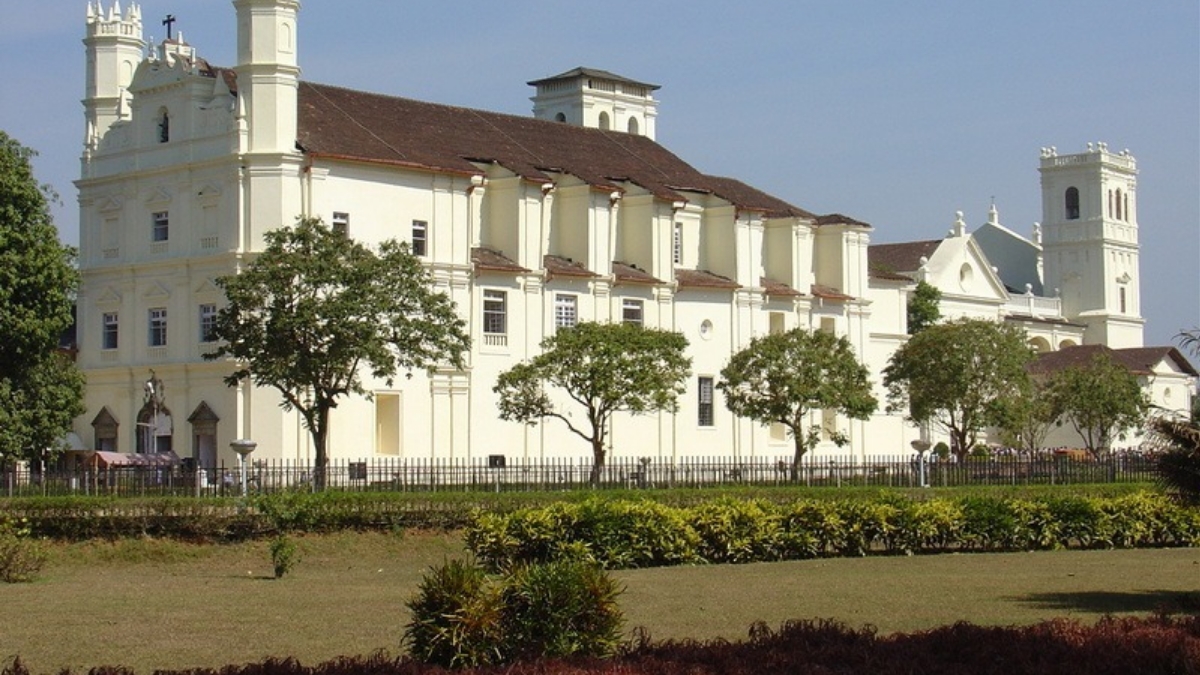Journeying west from the Se Cathedral, one comes upon the Old Palace of the Archbishop, which serves as a conduit from the cathedral to the Church of St. Francis of Assisi.
Thanks in part to its renovation in 1665, this graceful building displays a charming mix of architectural styles and intricately carved artwork. The adjoining convent has long since been converted into the Archaeological Museum and is worth a visit in its own right. No tour of Old Goa could be complete without a visit to this twofold attraction.
Claim to Fame For Church of St. Francis of Assisi
The blending of Portuguese-Manueline style portal from the older structure into the later Tuscan style building, to produce a unique specimen of architecture. The adjoining convent houses the Museum of Archaeological History.
History, Construction and Architecture of Church of St. Francis of Assisi
The original shrine, constructed by the Fransican monks in 1521 and subsequently enlarged, was showing signs of decay, so a new church was constructed and dedicated to the Holy Spirit. Built in 1665, it retained the portal of the old structure which was in the Portuguese–Manueline style. It is a unique architectural specimen, of this style in the country.
The façade of the church is built in the Tuscan style of architecture with only the portal being Manueline since it is a relic from the older structure. The façade is also distinctive in that it is flanked by octagonal towers.
In 1517, eight Franciscan monks landed in Goa. They immediately set to work and built themselves a small chapel. This chapel was completed in 1521 and dedicated to the Holy Ghost. This building was later expanded upon and later consecrated as a church in 1602. However, it was not in good repair and it was later torn down and reconstructed in 1665.
The St. Francis of Assisi church is built of laterite blocks, covered with lime plaster. The original Manueline entrance way is flanked by two octagonal towers. The façade of the church is three tiered and has a small niche which houses the statue of Our Lady of Miracles which was brought from Jaffna in Sri Lanka.
Interior and Art at Church of St. Francis of Assisi
In contrast to the simple outer façade the interiors of the church are unabashedly and lavishly decorated in the Baroque style using Corinthian influences. The highlight is the main altar, which has fine examples of this kind of work.
The altar is dedicated to St. Francis of Assisi and has above it a huge statue of the saint, and another of Jesus. These statues display excellent features and attention to detail. Flanking the altar are superb paintings on wood depicting scenes from the life of St. Francis of Assisi and the history of the Seraphic Order.
Although this church is not as large as the illustrious Se Cathedral, it is beautiful nonetheless. It is a single-nave church with three small chapels on either side of the nave. There are two altars besides the main one, which is dedicated to St. Francis of Assisi. Behind the altar are rooms which form the sacristy and there is a belfry to the north of the altar. The chapels and the gallery which runs around the top of the church are separated by internal buttresses.
Designed in a Baroque style the interior of the church is richly decorated. As you enter, on the left is an intricately carved wooden pulpit, decorated with floral patterns. The interior of the church itself is lavishly decorated with paintings depicting scenes from the Bible. The internal buttress walls have been carved with floral frescoes in the Indo-Portuguese Baroque style.
There are inscribed tombstones set into the stone floor of the church, many of which are worthy of note as they have been intricately carved. The main altar is carved and gilded, and beneath the statues of St. Francis of Assisi and Jesus is inscribed the vows of the saint “poverty, humility and obedience”. Beneath the main vault, is a richly carved niche containing the tabernacle, used for the repose of the Blessed Sacrament. The tabernacle is supported by sculptures of the Four Evangelists, Matthew, Mark, Luke and John.

Convent and Museum of Archaeological History
The Convent was built by the Franciscan friars around 1527 and later expanded. Today it houses the museum, established by the Archaeological Survey of India in 1964. Valuable sculptures and icons of pre-Portuguese era and portraits of Viceroys and Governor- Generals are displayed here.
This westward facing church has watched patiently over the faithful and seen the sun set on the Portuguese reign in India. The convent having been at first the simple living quarters of the Franciscan monks, then a convent and now a museum, is a timeless place, well worth a visit.


